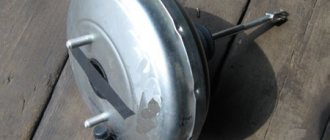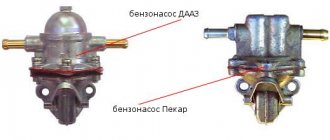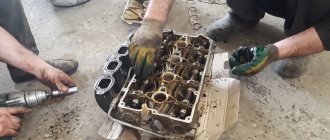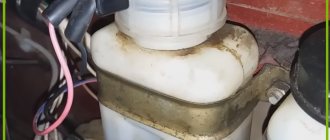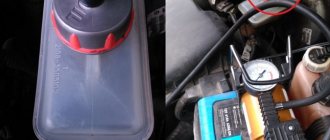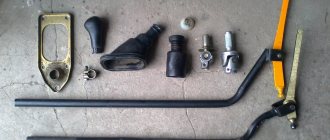05.09.2019
| (Votes: 4, Rating: 5) |
Issues discussed in the material:
- Why do you need a brake caliper?
- What types of brake calipers are there?
- How to replace a brake caliper
- What problems do brake calipers have?
The brake caliper is the best-selling car part. It is responsible not only for the performance of the car, but also for the safety of the driver and passengers. There is high competition in the market among sellers of these parts, because each manufacturer strives to improve the reliability of its products.
Purpose of the brake caliper
The brake system caliper is necessary to hold the pads; it ensures that they are fully pressed against the brake disc. This mechanism is a metal body with brake pads, pistons and seals located inside. The pressed brake pedal transmits pressure through the brake fluid to the pistons, which in turn act on the pads, pressing them on both sides to the disc rotating with the wheel. As a result, friction between the pads and the disc occurs and the car begins to slow down.
In this case, the caliper does not force the pads away from the disc - they are retracted spontaneously as the disc rotates. To ensure effective braking, an extremely small gap is left between the pad lining and the disc surface.
Clamping devices for brake systems are produced in large quantities - both for assembly line production of cars and for sale as spare parts. Moreover, due to strict selection and quality control, the products of only a few manufacturers who have a high level of quality and are authorized as official suppliers enter the conveyor. Accordingly, the price category of these products is higher compared to “non-original” products, but the service life is comparatively longer.
If the brakes rattle
This type of brake has pressure springs or floating calipers.
They are responsible for securing the pads to the caliper body. The reason for their failure is metal fatigue or poor quality. As a result, they lose their elasticity and stop pressing the pads against the body. Because of this, the pads rattle at the slightest passage of irregularities and may come into uneven contact with the disc, which will lead to the appearance of a shoulder or grooves on it. Also in this case, the staples themselves may rattle.
What should you do when your brake calipers or pads rattle? If it is not possible to replace them, then you should try to loosen them with your own hands using pliers to make them more rigid. To do this, you need to pull them out of their seats, unclench them and insert them into place, after which they will stop rattling for a while.
Types of brake calipers
There are 4 main characteristics by which these devices are classified:
- location (front brake caliper and rear brake caliper);
- presence or absence of a handbrake mechanism;
- device design (fixed mechanism or mechanism with a floating bracket);
- number of pistons: 1, 2, 4, 6 or 8 (six- and eight-piston devices are usually installed on expensive sports cars).
The last two signs are worth examining in more detail in order to identify the features of the mechanisms based on them.
The principle of operation of the caliper is directly related to its design features. So, in a fixed device, the pistons are placed on both sides of the brake disc, they act on all the pads simultaneously. A fixed mechanism, as the name suggests, is a stationary unit in which all the work is done by pistons.
The caliper design with a floating caliper is fundamentally different. The elements of this type of assembly are movable, and the pistons are located only on the inside of the disk. When you press the brake pedal, the piston presses the pad against the inner surface of the disc and simultaneously moves the mechanism towards the bracket, which in turn presses the pad from the outside. For both pads to work in harmony, the guides must be kept in excellent condition.
1. Fixed mechanism.
This type differs from devices with a floating caliper by at least twice as many pistons, which are located on both sides of the brake disc. Therefore, braking requires at least two pistons.
For greater reliability, fixed-type calipers are equipped with at least four pistons. In this case, if one of the pistons fails, the remaining pair will perform its function - press on the pads and brake the wheel.
Fixed mechanisms are more expensive than devices with a movable bracket - this is the only disadvantage of this type of caliper. The advantages worth noting are the following:
- Due to the rigid fastening of the device to the hub or steering knuckle, there are no vibrations or knocks from the caliper mounting, which means it lasts longer and is not subject to destruction. In addition, such a mechanism is less susceptible to corrosion.
- The pads are attached more securely compared to the option with a movable bracket.
Fixed mechanisms with more pistons have greater braking efficiency. This is especially important for modern and sports cars with significant maximum speeds or increased weight. In addition, sports cars are often equipped with large diameter brake discs. The need for such a configuration is explained by several reasons.
Firstly, with increasing speeds and masses, heat transfer also increases. Pads and discs heat up during friction, which generally has a negative effect on the braking system. Increased temperature of brake elements is one of the main obstacles that interferes with the normal operation of the system.
The large working area of the pads, and therefore a large number of pistons and increased caliper dimensions, contributes to better heat transfer compared to smaller pads made of the same material. For the same reason, the rotors are made larger.
Second, the four-piston brake caliper (two pairs of pistons positioned opposite each other) can be configured so that the front pair engages slightly before the rear pair. This will provide better control over the driving situation and improve modulation, which is especially significant, for example, on wet asphalt. Also, such a setting is important in sports racing or in some extreme conditions (for example, braking or a sharp turn on a gravel surface). Gradually increasing braking force will give greater stability, although much depends on the specific settings.
Finally, the third reason is quite banal: the more pistons, the greater the total force they exert. It is known that a large brake pad has more friction material, which must be pressed against the entire area to ensure effective braking. Many pistons can stop a car faster if there is enough tire grip at the moment of braking.
We recommend
“What kind of lubricant to lubricate calipers: choosing the best composition” More details
2. Mechanism with a floating bracket.
This type of caliper has a weak point - guides that serve for the reciprocating movement of the unit and for fastening the entire device. The guide pins need protection from moisture and corrosion, so special boots are placed on the fasteners. Damage or wear of such anther can subsequently lead to souring of the finger and the appearance of rust on it. Because of this, the movable element of the caliper will move jerkily along the guide or get stuck on it, not pressing the pads tightly enough to the disc and worsening braking efficiency. This also leads to increased wear of the outer pad.
These guides also cope less well with vibrations and shocks transmitted through the wheel as a result of driving over uneven surfaces. If the guides are worn out, knocking and play occur inside the mechanism. All this is accompanied by uneven wear of the pads and brake discs.
This mechanism also has advantages:
- Floating calipers are cheaper than fixed calipers, although sometimes not significantly so.
- These mechanisms are structurally simpler and more compact than monoblocks, despite the presence of moving parts. They contain many times fewer pistons, cylinders and sealing elements.
To use devices of any design for as long as possible, it is enough to pay attention to their weak points and adhere to careful driving, as well as undergo timely maintenance - the most convenient way to check all vehicle systems at once.
A reasonable question arises: which design is more reliable? Provided that the driver drives carefully, the driver follows operating rules and undergoes regular maintenance, a fixed caliper will last longer than a mechanism with a movable caliper.
Caliper Lubricant
Is it possible to lubricate the “fingers” with any available lubricant? Unfortunately no. The reason is that the caliper operates at high temperatures, especially if the car is heavy or the driver likes to drive. In this case, both the caliper, the guides, and the lubricant on them heat up.
For this reason, the most common lubricants are no longer needed: they are based on mineral oils and, when heated, liquefy and flow off the metal.
The second reason why you cannot use lithol, grease, or even higher-quality ceramic and copper lubricants is their interaction with rubber boots. Most lubricants damage the rubber, the boots slip out of their places, and the fingers are left without protection.
What to lubricate with?
Only what the manufacturer calls guide lubricant. Bosch, Liqui Moly and other auto chemical manufacturers have such products. One of the indicators that a lubricant is suitable is high-temperature stability, maintaining properties when heated to at least 200 degrees.
Why can the store offer the wrong thing? Simply because there are other lubricants for calipers, such as ceramic and copper anti-squeak lubricants, which are applied to the metal plate of the pads. Yes, they do their job perfectly, but they are not suitable for fingers!
Malfunctions and repairs of brake calipers
In most cases, cars are equipped with single-piston calipers with a floating caliper. On high-power vehicles, fixed-type mechanisms with two or more pistons are installed. The rear brakes often include a parking brake system, which in most modern cars operates through working pads.
These systems have moving parts, which in the minimum configuration include hydraulic cylinders (one per clamping mechanism) and guides. If there is an integrated parking brake, this also includes a mechanical pad pressing system. In addition to moving elements, hydraulic shut-off valves are subject to wear. As a result of constant temperature influences, the coating of the caliper surface is gradually erased, which entails its oxidation.
The guide pins and anthers of hydraulic cylinders, which act as shock absorbers and elements of the self-supplying system, are most sensitive to wear. As soon as these parts wear out, the brakes begin to jam, overheat and make characteristic sounds.
In addition to the wear of these elements, other problems arise. A worn boot can lead to corrosion of the working piston and cylinder surface. In addition, the geometry of some elements of the caliper (especially light alloy), in particular the floating caliper, may be disrupted. This is caused by uneven cylinder pressure on the brake disc, significant overheating or mechanical impact of a foreign object.
Separately, it is worth mentioning the rear devices with an integrated hand brake. Having appeared in the 1980s, systems like Teves/ATE have today practically replaced other types of parking systems. In these mechanisms, in addition to the main working elements, housing elements, fasteners, studs and rods damaged by corrosion, as well as other components may require repair.
The service life of a brake caliper, as a rule, exceeds 7-8 years, even when operating in our climatic conditions. Exceptions are calipers with light-alloy pistons, devoid of anthers. For example, these are multi-piston Lockheed/AP Racing mechanisms, which are installed in powerful SUVs and crossovers, as well as sports cars. Repair of this type of brake calipers (especially those with original chrome-plated aluminum pistons) is often required much earlier.
Erroneous actions of car service specialists can also cause breakdowns and repairs of brake mechanisms. This situation most often occurs with rear calipers equipped with a parking brake. Repair is usually required after the wrong choice of pads, their incorrect installation, or dirt getting into the mechanism. And all sorts of sounds made by the brakes, in this case, are not a signal for urgent action. Instead, you should pay attention to uneven braking, insufficient efforts of the braking system and incomplete release of the brakes, and fluid leakage from the system.
We recommend
“Which lubricant to use for calipers: making the right choice” Read more
Repair begins with disassembling and cleaning the device. Disassembling this mechanism is not always easy, and if there is an integrated parking brake, special tools and appropriate skills in working with it may be required. Cleaning is carried out in an equipped service center using shot blasting; much less often, chemical cleaning or mechanical treatment with special brushes and drill attachments is used.
The channels of the hydraulic system are separately cleaned of rust. In this case, fittings and shut-off valves must be replaced. On multi-piston calipers, the external connecting tubes must be cleaned and inspected. If necessary, they can also be replaced.
Complete disassembly of the brake mechanism allows you to decide whether it can be repaired. It makes no sense to repair the caliper if there is deep corrosion of the cylinders or mechanical damage, but only if the mechanism is unique.
If you decide to restore the mechanism, it should first be thoroughly cleaned. In some cases, when creating new attachment points, additional metal is welded on, which is painted if necessary. Then you need to select or make pistons. When steel is used for manufacturing, the pistons are subsequently chrome plated.
Next, the anthers are attached to the new pistons (if they were previously installed), after which the hydraulic system is assembled. The process is completed by installing the remaining elements of the mechanism, including the parking brake (if equipped). The assembled mechanism is checked with a pressure of 200 kgf/sq.cm, identifying possible leaks.
Does it make sense to resort to repairs or is it easier to purchase a new mechanism? The financial component plays a major role here. Even the simplest original calipers will cost at least 15–20 thousand rubles, while the cost of multi-piston devices can reach 170 thousand. It should be taken into account that such mechanisms change in pairs.
Compared to buying a new mechanism, repairs will be cheap. For example, the cost of repairing popular Bosch models in specialized workshops varies in the range of 1,500–2,000 rubles. And taking into account the fact that parts subject to wear are replaced with new ones, the total service life of the mechanism will not be much lower than a completely new analogue.
How to choose a new brake caliper
To select a new mechanism, you can use three methods:
- Search by VIN code. This method can easily be used to find both original products and their closest analogues. Many experts recommend searching for a spare part by VIN code due to the almost zero risk of making a mistake with the choice.
- Search technical information. More specifically, you can search by make, model and configuration of the vehicle, which is also a good option. It is especially convenient to search in electronic systems, where these search parameters are set explicitly.
- Search by caliper code. In this case, you need to find out the code of the existing mechanism or find it out from other car owners.
In addition to this, it is advisable to have detailed information about the manufacturers. It is confirmed by facts that there are unscrupulous manufacturers of such important elements of the brake system, who, unfortunately, produce fakes of extremely low quality. Such products fail quite quickly, overheating during operation. In some cases, they can only be installed with a hammer.
Nevertheless, you should not refuse non-original devices. Unlike, for example, automotive sensors, the quality of calipers on the secondary market is often not inferior to original products. Here it is important to choose the right manufacturer, and the best at the moment are:
- NK (Denmark);
- Pagid (Germany);
- DelcoRemy (USA);
- ABS (Netherlands);
- Textar (Germany).
We recommend
“What kind of lubricant to lubricate calipers: choosing the best composition” More details
You can choose cheaper analogues, but the service life of such a mechanism will be incomparably lower. This option should only be considered as temporary if finances are limited at the moment. Replacing this part with a better one will still be inevitable, including as a result of a malfunction. Here are some other companies worth paying attention to:
- Profit (Czech Republic);
- Febest (Germany);
- JP Group (Denmark).
If you focus on the price/quality ratio, then the best option would be products from Febest (Germany). The quality of calipers produced by this company has increased dramatically in the last few years. Perhaps the reason for this jump lies in the increase in the volume of supplies not only to European countries, but also to Asia, which is generally characterized by increased requirements for the quality of spare parts for cars. Therefore, if you are looking for a quality mechanism but are on a budget, Febest will be the best choice for you.
The following companies produce fairly good brake caliper repair kits:
- Meyle (Germany);
- Autofren (Spain);
- Frenkit (Spain);
- Ert (Spain).
This predominance of Spanish manufacturers is confirmed by practice. It is this country that is distinguished by affordable prices for fully equipped and high-quality repair kits.
Procedure for replacing the brake caliper
The process of replacing the mechanism is quite simple. Special tools are required only for some car models.
In general, the set of tools and materials consists of:
- jack;
- supports for repairs;
- a set of wrenches (including a wheel wrench);
- wheel chocks;
- a set of screwdrivers (hexagonal and flathead);
- pressing clamp for pistons;
- pliers or vice;
- brake system cleaner;
- rags;
- pneumatic wrench;
- brake fluid supply;
- a clean drain pipe connected to the corresponding bolt (length approximately 60 cm);
- containers for draining waste liquid (for example, a plastic bottle with a lid).
First of all, you need to park the car on a flat and solid surface. A concrete surface that can withstand the pressure of a jack is best. Even asphalt in hot weather can sag under a jack, which will not benefit either the car or the asphalt. Replacing two calipers on one axle takes a beginner several hours. Keep this in mind if you plan to work in a shaded area or in the open sun.
Next, you need to decide which side of the car to deal with first. Further instructions will be given with the driver's side being processed first. When working with rear calipers, you must first remove the car from the hand brake.
Then lock the wheels on the opposite side. In our case, these are the front and rear wheels on the passenger side. This measure will prevent the machine from rocking in the longitudinal direction during operation.
The next step is to remove the hub caps and plugs from the wheels being processed to provide access to the wheel fasteners. The bolts only need to be loosened by unscrewing them no more than one turn. Then use a jack to lift the car, placing the jack in the strictly designated place.
To ensure stable support of the vehicle, use repair supports. Do not start work while the machine is supported only by a jack. When installing supports under the wheel axle, it is advisable to place them as close to the wheel as possible, avoiding the locations of the differentials. You should also not install a jack under the differentials.
Check the position of the supports, make sure they are close to the wheel, and adjust them if necessary. Next, completely unscrew the wheel mounting bolts and place them in the wheel cover, then remove the wheel from the car.
Then you need to open the brake bleeder valve with the closed part of the wrench. The valve is made of soft metal, so you should open it carefully, being careful not to damage the metal. Disconnect one end of the hose and immediately place it in a container to drain the brake fluid.
Press the piston back into the caliper using the existing clamp until the pads are firmly and constantly pressed against the rotor. When the piston is pressed into the container, brake fluid will begin to flow.
After draining, you need to disconnect the hose from the caliper using a spanner. Unscrew the end of the hose a maximum of half a turn to avoid kinking. If the hose is bolted to the brake mechanism, it can be removed completely.
Next, use a suitable set of wrenches to remove the caliper from the steering knuckle. The parking brake located on the rear brakes is accordingly removed from the caliper. This procedure may be performed differently in different machine models. In this case, it is important that the parking brake lever is lowered, otherwise it will not be possible to remove the mechanism.
We recommend
“How often to change the brake fluid and why to do it” Read more
After disconnecting the caliper, you need to turn it to the left so that the brake hose unscrews. It is advisable to leave the caliper with the hose bolt.
Next, select the appropriate replacement brake for the specific axle and side of the vehicle. You can check the correct installation by looking at the thread for attaching the brake hose - it should ultimately be located on top. If the caliper is installed incorrectly, air will begin to enter the system. Place both mechanisms next to the brake disc and install the one with threads on top.
In the process of checking and replacing brake calipers and pads, it is also necessary to check the brake discs. They will probably need to be sharpened to remove irregularities and damage.
If a pressing clamp was not used when removing the caliper, the corresponding piston must be pressed in when installing new pads. Then connect the hose to the installed caliper, after replacing the copper washers that should come with the new mechanism. Mount all elements on top of the brake disc.
Then, in reverse order, secure the caliper to the steering knuckle and securely, but without unnecessary effort, screw the brake hose onto the mechanism.
Next, install the drain screw and secure the end of the transparent tube to it. Lower the other end into an empty container prepared on the ground and release the hose clamped with a vice or pliers. Then check the brake fluid level in the reservoir by opening the hood. If necessary, the liquid must be added to the minimum level.
For further operation, you will need an assistant who needs to press the brake pedal several times and hold it in this state the last time you press it. After this, tighten the drain bolt and ask an assistant to bleed the brakes again by pressing three times and holding the pedal down. Then unscrew the bolt back, releasing the air, and tighten it again. This procedure should be repeated until air is completely removed from the system. In this case, it is necessary to monitor the nature of the brake fluid flowing through the outlet tube into the container. As soon as clean liquid flows without air bubbles, tighten the drain screw, disconnect the tube and remove the container with liquid.
Press down on the brake pedal until it becomes tight enough. The pedal should be pumped with the engine turned off. Now you can put the wheel in place. Slide it evenly onto the hub and secure with bolts or nuts. It is not necessary to tighten the fasteners tightly at this stage; you can tighten them later.
Carefully lower the side of the car on the jack and remove the jack. Finally tighten all wheel bolts and nuts to the required torque. They need to be tightened not in order, but along the line drawing a star.
Fill the reservoir with fluid to the required level, close the reservoir and hood. Any liquid that gets on the paintwork must be immediately removed with a cloth and the area washed with water, since brake fluid can quickly destroy the coating.
Once you are done with the driver's side of the car, repeat all the steps listed on the passenger side. When the brake system is ready for use, it must be checked. To do this, select a deserted section of the road where there are no residential buildings, and drive slowly along it. Finally, re-tighten all the wheel bolts and cover the wheels with wheel covers.
Design and principle of operation
Mandatory elements of any caliper are:
- Pad guides. They can be of different types, more complex for floating structures and relatively simple for fixed ones. Their task is to transfer the braking force from the linings pressed to the disc to the car chassis.
- Hydraulic cylinders that convert the increase in pressure in the brake drive system into the pressing force of the friction linings against the disc.
- Brake pads consisting of a durable metal substrate onto which linings made of a special heat-resistant material with a guaranteed coefficient of friction against steel or cast iron discs are glued.
After pressing the brake pedal, pressure increases in the system, which is transmitted to the working cylinders. The pistons begin to extend and clamp the disc on both sides through the pads.
A large amount of thermal energy is released, but thanks to the size of the disc and its ventilation system, it is successfully dissipated, simultaneously cooling the pad material.
However, the temperature of the caliper increases and to prevent boiling, special measures are taken to remove heat and the composition of the fluid itself.
This is interesting: Why do you need an adsorber in a car, device and principle of operation
When the pressure is removed, the pistons stop putting pressure on the pads, and due to the elasticity of the sealing cuffs on them, they move back a very small distance, on the order of tenths of a millimeter.
This is sufficient to prevent surface contact on one side and ensure high braking readiness on the other. The shorter this distance, the faster the brake will work the next time you press it without unnecessary free play of the pedal.
To remove air from the system, each cylinder block has a special bleeder fitting. It is usually located near the connection point of the flexible working pressure supply hose.
Recommendations for maintenance and repair of calipers
Often the guides or pistons in calipers become sour. The problem with the latter arises due to untimely replacement of the brake fluid. Water accumulates in the old fluid, which contributes to the rapid oxidation of parts. And the less often the car is used, the higher the likelihood of souring the pistons.
To prevent such a situation, you need to promptly change the brake fluid and bleed the brake system, regularly checking its operation. When changing the front pads, evaluate whether the pistons move normally. If recessing them requires significant effort, this is a reason to be wary.
There is a chance to rehabilitate pistons that are not completely soured by soaking them. To do this, brake fluid is supplied into the space behind the seals using a syringe. In order for the piston to come out of the cylinder, you need to press the brake pedal many times, then the piston is retracted again. Repeat the operation until the piston moves freely. To prevent the piston from completely falling out of the cylinder when extruded, you can make a stop, for example, from old pads that are placed directly in the caliper.
We recommend
“How to improve brakes (vacuum from Priora)” Read more
Acidification of the guides can be eliminated by removing them and cleaning them from dirt and traces of oxidation. Then the guides are treated with a suitable lubricant (litol or its analogues). It is necessary to process not only the guides, but also the holes in which they are placed. If the anthers and springs are significantly worn, it is more advisable to replace the pins with new ones.
Fill only with fresh fluid. If the brake fluid reservoir has been left open for some time, moisture may have entered, which may subsequently cause corrosion of surrounding metal parts.
Keep in mind that on most car models, approximately 70% of the braking force is produced by the front brakes. It follows from this that the secondary replacement of the front pads will most likely require replacement of the rear ones.
